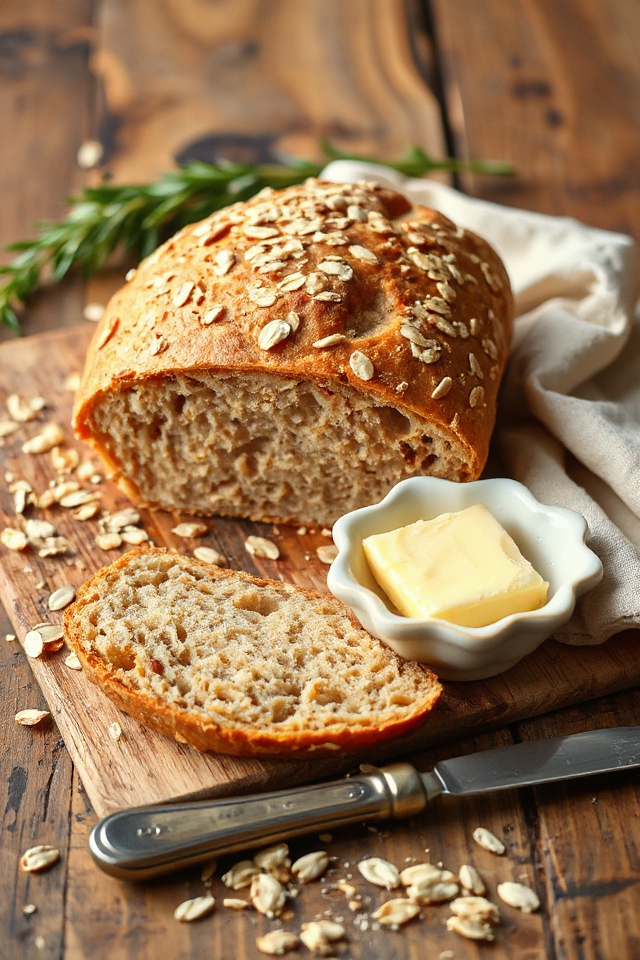Why You’ll Love This Oat Bread Recipe
If you’re looking for a bread that’s both hearty and delicious, you’ll love this oat bread recipe. I can’t get enough of its warm, comforting texture and nutty flavor.
It’s perfect for breakfast, slathered with butter and jam, or as a side for soups and stews. What I really appreciate is how easy it’s to make—no complicated techniques or fancy ingredients.
Plus, it’s packed with wholesome oats that provide a nutritious boost. Each slice feels satisfying, making it a great choice for any meal.
Trust me, once you try it, you’ll want to bake it again and again!
Ingredients of Oat Bread
When it comes to baking bread, the ingredients can make all the difference. For this oat bread recipe, you’ll find that the ingredients are simple and wholesome, giving you a delicious loaf without any fuss.
Let’s take a closer look at what you’ll need to whip up this comforting bread that’s perfect for any meal.
Here’s what you’ll need:
- 3/4 pint milk
- 4 ounces rolled oats
- 12 ounces flour
- 1 teaspoon salt
- 4 teaspoons baking powder
- 6 ounces caster sugar
- 1 egg, beaten
- 1/2 ounce butter, melted
Now, let’s chat a bit about these ingredients. The rolled oats are the star of the show, adding a lovely texture and nutty flavor that makes every bite feel hearty.
If you’re feeling a bit adventurous, you could even try using whole grain oats for a slightly nuttier taste. Don’t worry if you don’t have caster sugar; you can use regular granulated sugar instead—though it mightn’t dissolve as quickly.
And about that milk—scalding it helps bring out the flavor and gives the oats a chance to soften up, so don’t skip that step.
This bread doesn’t require yeast, which means no waiting for dough to rise, giving you more time to enjoy the process (or sneak a cookie while you bake).
How to Make Oat Bread

Now that you have your ingredients ready, it’s time to engage in the fun part: making the oat bread. First things first, you’ll want to scald 3/4 pint of milk. This sounds fancy, but don’t worry, it just means heating the milk gently until you see little bubbles forming around the edges.
Pour that warm milk over 4 ounces of rolled oats in a bowl, give it a gentle stir, and then let it cool off for a bit. I usually find something else to do during this time—maybe get distracted by my latest Netflix series. Just don’t forget about the oats, okay?
While your oats are cooling, grab another bowl and sift together 12 ounces of flour, 1 teaspoon of salt, and 4 teaspoons of baking powder. This is where you start to feel like a real baker.
Once that’s sifted, add in 6 ounces of caster sugar. Now, beat in 1 egg (that you’ve beaten already, of course) and 1/2 ounce of melted butter. It’s like a party in your bowl. After mixing that all together, fold in your oat mixture. You’ll notice it turns into a thick, porridge-like batter—don’t be alarmed; that’s how it should look.
Next, pour this lovely mix into a well-buttered 2 lb loaf tin. It’s important to let it stand for about 15 to 20 minutes. This step is essential for letting the flavors mingle and for the oats to soak up some of that milk goodness.
Preheat your oven to 350ºF (or mark 4 if you’re using a gas oven). Once your batter has sat for a bit, pop it in the oven for 1.5 hours. But here’s a pro tip: after 30 minutes, cover the top with a piece of very lightly buttered kitchen foil. This will help keep it from browning too much.
Then, just sit back, relax, and maybe even dance a little while you wait for the delicious aroma of baked oat bread to fill your kitchen. Once it’s done, let it cool on a wire rack before slicing it thick and slathering it with butter. Now, that’s what I call a satisfying reward for your hard work.
Oat Bread Substitutions & Variations
While the classic oat bread recipe is delightful as is, there are plenty of substitutions and variations you can try to suit your taste or dietary needs.
For a gluten-free option, swap out regular flour for a gluten-free blend. If you’re looking to cut sugar, consider using a natural sweetener like honey or maple syrup.
You can also add ingredients like nuts, seeds, or dried fruits for extra flavor and texture. Experimenting with different types of milk, like almond or oat milk, can also change the taste.
Don’t hesitate to get creative and make this recipe your own!
Additional Tips & Notes
To guarantee your oat bread turns out perfectly every time, I recommend measuring your ingredients accurately and using room temperature milk and eggs.
If you want a richer flavor, consider adding a tablespoon of honey or maple syrup.
Don’t rush the cooling process; allowing the bread to cool on a wire rack helps maintain its texture.
If you’re storing leftovers, wrap them tightly to keep them fresh.
For a fun twist, try adding nuts or dried fruits to the batter.
And remember, every oven is different, so keep an eye on your bread as it bakes to avoid over-browning.
Enjoy!
